Study on Water Inflow Variation Law of No.1 Shaft Auxiliary Shaft in HighLiGongshan Based on Dual Medium Model
Abstract
:1. Introduction
2. Seepage Simulation of Fractured Rock Mass Based on Fluid Structure Coupling Method
2.1. Engineering Background
2.2. Geological Conditions
2.3. Hydrologic Condition
2.4. Establishment of Discrete Fracture Network
2.5. Establishment of Dual Medium Model
3. Site Pumping Test
3.1. Construction Plan
3.2. Experimental Data
4. Derivation of Water Inflow Prediction Formula
4.1. Basic Assumption
- (1)
- The seepage conforms to Darcy’s law, that is, the seepage velocity in a certain direction is proportional to the hydraulic gradient.
- (2)
- The permeability coefficient of the rock stratum is the same in all directions.
- (3)
- Study only steady flow (time independent).
- (4)
- The influence radius is 2 H, and H is the distance from the still water surface to the bottom of the well [58].
- (5)
- The seepage field accords with Dupuit hypothesis.
4.2. Formula Derivation
5. Result
5.1. The Prediction Results of This Formula Are Compared with Those of the Original Big Well Method
5.2. Variation Law of Water Inflow in Working Face during Shaft Excavation
5.3. Variation Law of Shaft Wall Water Inflow during Shaft Excavation
5.4. Variation Law of Total Water Inflow during Shaft Excavation
5.5. Comparative Analysis of Simulation, Theory and Measurement.
6. Conclusions
- (1)
- The simulation results of the proposed seepage model of fractured rock mass are in good agreement with the reality, which can better reflect the influence of the existence of fractures on the changes of pore pressure and water inflow. The existence of fractures will weaken the pore pressure field around, which is about 0.3 times of the pore pressure field of porous media.
- (2)
- Comparing the simulation results of grouting and non-grouting, it is found that the water inflow of grouting excavation is significantly reduced compared with that of non-grouting excavation, especially when passing through the area where the fracture is located. Compared with the monitoring data of the total water inflow in different stages, it is found that the total water inflow increases sharply when passing through the fracture area, and decreases after passing. With the progress of excavation, the total water inflow presents a decreasing trend, with the increase of shaft excavation depth, the change rate of normal total water inflow in shaft increases gradually, which is consistent with the monitoring data.
- (3)
- Compared with the theoretical calculation results, the grouting simulation results are more close to the measured water inflow, and the numerical simulation method is a good means for construction in complex water rich areas. Compared with the formula of original pressure to no pressure, the water inflow prediction formula proposed in this paper is more sensitive to the permeability coefficient, and the calculated results are larger, so it has greater safety reserves.
- (4)
- With the progress of excavation, the total water inflow of shaft increases, and the difference of water inflow before and after excavation is nearly three times. Meanwhile, the proportion of shaft wall water inflow to the total water inflow gradually increases from 50% to about 70%, and the proportion of shaft wall water inflow to the total water inflow is proportional to the excavation depth of the shaft.
- (5)
- The formula presented in this paper is applicable to the engineering with symmetrical structure and horizontal stratum such as shaft. Further research is needed for tunnel engineering. At present, the prediction of steady flow water inflow is gradually improving, and the numerical simulation and analytical solution can accurately predict the project water inflow. However, it is still difficult to predict the water inflow of a kind of unsteady flow, such as water inrush.
Author Contributions
Funding
Institutional Review Board Statement
Informed Consent Statement
Data Availability Statement
Conflicts of Interest
References
- Long, J.C.S.; Witherspoon, P.A. The relationship of the degree of interconnection to permeability in fractured networks. J. Geophy. Res. 1985, 90, 996–1010. [Google Scholar]
- Long, J.C.S. Porous media equivalents for networks of discontinuous fractures. Water Resour. Res. 1982, 18, 32–37. [Google Scholar] [CrossRef] [Green Version]
- Gao, J.; Xiang, Y.; Lei, H. Flow heat transfer stress model and discrete element simulation of sparsely non orthogonal fractured rock mass. Acta Geol. Sin. 2019, 25, 502–511. [Google Scholar]
- Lu, W.; Xiang, Y.; Li, T. Experimental study on flow heat transfer model of rock mass without filling fracture. J. Rock Mech. Eng. 2011, 30, 3884–3891. [Google Scholar]
- Lu, W.; Xiang, Y.; Tang, C. Model test and numerical simulation of seepage and heat transfer in sand filled fractured rock mass. Geo. Mech. 2011, 32, 3448–3454. [Google Scholar]
- Tang, C. Seepage of Sand Filled Fractured Rock Mass Heat Transfer Model Experiment and Numerical Simulation. Master’s Thesis, Beijing Jiaotong University, Beijing, China, 2011. [Google Scholar]
- Yang, X.; Kang, J.; Liu, Z. Analysis on unsaturated rainfall infiltration characteristics of fractured rock slope. Bulle. Soil Water Conser. 2016, 36, 143–147. [Google Scholar]
- Chen, H. Stress of Fractured Rock Mass Injury-Seepage Coupling Theory Experimental and Engineering Application Research. Ph.D. Thesis, Central South University, Changsha, China, 2010. [Google Scholar]
- Sheng, J. Calculation and Analysis of Equivalent Continuum of Water Inflow and Water Pressure in Fractured Rock Tunnel. Master’s Thesis, Beijing Jiaotong University, Beijing, China, 2006. [Google Scholar]
- Wang, J.; Chen, X.; Zhang, Z. Calculation of fracture water seepage based on discrete fracture network model. Kar. Ch. 2016, 35, 363–371. [Google Scholar]
- Yang, D.; Zhao, Y.; Duan, K. Hydraulic model and finite element simulation of generalized dual media rock mass. J. Rock Mech. Eng. 2000, 19, 182–185. [Google Scholar]
- He, C.; Yao, C.; Yang, J. Seepage model of 3D fractured rock mass based on equivalent discrete fracture network. J. Rock Mech. Eng. 2019, 38, 2748–2759. [Google Scholar]
- Du, G.; Zhou, W. Seepage model of multiple fracture networks in fractured media. J. Rock Mech. Eng. 2000, 16, 1014–1018. [Google Scholar]
- Wang, Z.; Wang, H.; Sun, Y. Study on seepage model of double fracture system. J. Rock Mech. Eng. 1998, 17, 400–406. [Google Scholar]
- Zhu, B.; Gao, F.; Yang, J. Study on fracture pore double seepage simulation of deep thin coal and rock mass. J. China Univ. Min. Tech. 2014, 43, 987–994. [Google Scholar]
- Yang, J. Study on numerical simulation theory and method of fracture vuggy unit in fracture vuggy carbonate reservoir. Master’s Thesis, China University of petroleum, Shandong, China, 2006. [Google Scholar]
- Pan, X.; Song, L.; Niu, T. Geological modeling method for double porosity reservoir in granite buried hill. J. Southwest Pet. Univ. Sci. Technol. Ed. 2019, 41, 33–44. [Google Scholar]
- Liu, Y.; Li, S.; Liu, X. Coupled seepage stress model of dual media based on continuum discrete element method. J. Rock Mech. Eng. 2011, 30, 951–959. [Google Scholar]
- Liu, Y.; Yang, Q.; Huang, Y. Numerical analysis of seepage stress coupling based on dual porous media model. J. Rock Mech. Eng. 2007, 26, 705–711. [Google Scholar]
- Rutqvist, J. A modeling approach for analysis of coupled multiphase fluid flow, heat transfer, and deformation in fractured porous rock. Int. J. Rock Mech. Min. Sci. 2002, 39, 429–442. [Google Scholar] [CrossRef]
- Nian, G.; Chen, Z.; Zhou, Z. Seepage and stability analysis of fractured rock slope based on dual medium model. J. Coal Ind. 2020, 16, 166–169. [Google Scholar]
- Liu, W.; Wang, D.; Su, Q. Dual media model and seepage simulation based on shale reservoir anisotrop. Nat. Gas Geol. 2016, 27, 1374–1379. [Google Scholar]
- Pan, G.; Wu, Q. Study on seepage and seepage model of dual medium fracture network in Jiaozuo mining area. Carsologica Sinica. 1998, 17, 363–369. [Google Scholar]
- Chen, G.; Song, L.; Liu, L. 3D numerical simulation of elastic wave propagation in discrete fracture network rocks. Pure Appl. Geolphys. 2019, 16, 66–69. [Google Scholar] [CrossRef]
- Zhang, Y.; Peng, L. 3D fracture network of rock mass based on Monte Carlo method model research. J. Gan. Sci. 2020, 32, 124–131. [Google Scholar]
- Shan, D.; Yan, T.; Li, W. Random fracture network reservoir and wellbore heat flow coupled numerical simulation. Nat. Gas Ind. 2019, 39, 143–150. [Google Scholar]
- Zhu, Y.; Wang, X.; Deng, S.; Chen, W.; Shi, Z.; Xue, L.; Lv, M. Grouting process simulation based on 3D fracture network considering fluid–structure interaction. Appl. Sci. 2019, 9, 667. [Google Scholar] [CrossRef] [Green Version]
- Li, D.; Liu, J.; Chen, L. Modification of 3D fracture network modeling technology and its engineering application. J. Under. Space Eng. 2020, 16, 1476–1483. [Google Scholar]
- Shen, R. Research on 3D stochastic simulation method of fracture network. J. Heilongjiang Inst. Technol. 2020, 34, 11–16. [Google Scholar]
- Zhang, J.; Sheng, J.; Huang, T. Study on permeability and fractal characteristics of rock fracture network. Chem. Min. Pro. 2020, 49, 29–34. [Google Scholar]
- Ruan, J.; Zhang, J.; Zhang, C. Numerical simulation of the influence of discrete fracture network on mechanical properties of rock mass. J. Hebei Eng. Univ. 2021, 38, 40–46. [Google Scholar]
- Xia, Y.; Yao, C.; He, C. 3D random fracture analysis based on LHS method network numerical simulation and seepage analysis. Hydropower Energy Sci. 2019, 37, 139–143. [Google Scholar]
- Han, S.; Li, M.; Wang, G. Polygonal fracture network simulation of rock mass based on control circle method and iterative inversion. J. Mech. Eng. 2019, 38, 1635–1646. [Google Scholar]
- Huang, B.; Wang, J.; Yin, Y. Study on regional distribution of rock mass deterioration in water level fluctuating zone based on fracture network. J. Underground. Space Eng. 2020, 16, 1901–1908. [Google Scholar]
- Wu, Z.; Wang, Z.; Guo, W. Artificial neural network prediction of nonlinear seepage model parameters in plane cross fracture. J. Eng. Geol. 2020, 28, 982–988. [Google Scholar]
- Wei, Y.; Zhang, S.; Chen, T. Height Prediction of Water Flowing Fractured Zone in Coal Mine Based on BP Neural Network Optimized by Genetic Algorithm. In Proceedings of the SPG/SEG Nanjing 2020 International Geophysical Conference, Nanjing, China, 13–16 September 2020. [Google Scholar]
- Wu, J.; Zhou, Z.; Zhuang, C. Analytical study on distribution of water inflow and pore pressure of tunnel under drainage condition. J. Geotech. Eng. 2020, 42, 1894–1902. [Google Scholar]
- Li, Z.; Liang, X.; Guo, F. Application of big well method in calculation of water inflow of foundation pit. People’s Yangtze River. 2009, 40, 50–55. [Google Scholar]
- Li, C.; He, F.; Chen, C. New method for calculating karst water inflow of Wulong Tunnel on Chongqing Huaihua Railway. China Railw. Sci. 2005, 33, 41–46. [Google Scholar]
- Lu, Q.; Li, J. Analysis of parameters in calculation formula of tunnel water inflow. Water Conserv. Hydropower Eng. Des. 2020, 39, 8–10. [Google Scholar]
- Yan, C. Application of unsteady flow analytical method in predicting mine water inflow. Metal. Manag. 2019, 16, 88–89. [Google Scholar]
- Li, X.; Huang, H.; Shan, Z. Influencing factors and calculation analysis of water inflow of meihuajing coal mine in Ningxia. Coal Tech. 2019, 38, 113–115. [Google Scholar]
- Bi, K.; Niu, Y.; Yan, X. Analysis on calculation method of water inflow from exploration and drainage drilling hole in coal mine. Inner Mongolia Coal Econ. 2020, 26, 20–21. [Google Scholar]
- Xie, W.; Yang, X. Prediction and calculation of sectional water inflow of zhedoshan tunnel based on analytical method. Highway 2019, 64, 318–324. [Google Scholar]
- Xu, K.; Zhao, Y.; Zhu, Y.; Jiu, Y. Study on calculation method of water inflow of super large rectangular deep foundation pit phreatic incomplete well. J. Insti. Tech. 2020, 31, 36–41. [Google Scholar]
- He, Z.; Wan, H.; Hu, K. Prediction and analysis of water inflow from shaft construction. Min. Eng. Res. 2018, 33, 31–35. [Google Scholar]
- Liu, J.; Jin, D.; Wang, H. Calculation and parameter optimization of drilling water inflow based on aquifer borehole water exchange. Acta Coal. Sin. 2010, 11, 6–10. [Google Scholar]
- Tang, Y.; Zhang, J.; Li, L. Calculation method of pumping well water yield based on wavelet neural network substitution model. Hydropower Energy Sci. 2020, 38, 17–20. [Google Scholar]
- Wang, L.; Zhang, W.; Luo, Y. Calculation method and reliability of mine water inflow in the first mining area of jiageilongwa mining area. J. Q. Univ. 2019, 37, 63–71. [Google Scholar]
- Wang, J.; Yang, L.; He, J. Trial flow method in numerical calculation of water inflow of deep tunnel. J. Rock Mech. Eng. 2002, 10, 1776–1780. [Google Scholar]
- Qin, Z. Finite element analysis of confined water foundation pit inflow. Fujian Cons. Sci. Tech. 2020, 11, 39–42. [Google Scholar]
- Tang, N.; Wang, L.; Zhou, N. A new method for predicting water inflow of karst tunnel—A case study of Zhongliangshan karst tunnel project. Fujian Cons. Sci. Tech. 2021, 52, 141–148. [Google Scholar]
- Wang, J.; Wang, S.; Huang, Q. Prediction of coal mine water inflow based on correlation analysis method. S. X. Coal. 2021, 40, 99–102. [Google Scholar]
- Wan, L.; Wang, Y.; Zhang, W. Dynamic prediction of water inflow in Ordovician limestone aquifer based on water abundance distribution. Sci. Tech. Eng. 2021, 21, 3057–3602. [Google Scholar]
- Tian, G.; Wang, J. Prediction and analysis of water inflow in hanglaiwan mine based on numerical simulation. Energy Technol. Manag. 2021, 46, 13–16. [Google Scholar]
- Fu, H.; Li, J.; Cheng, G. Prediction of tunnel water inflow in fault affected area based on conformal mapping. J. Huazhong Univ. Sci. Technol. 2021, 49, 86–92. [Google Scholar]
- Zhou, L.; Yang, G.; Yang, Q. Study on water inflow prediction of Karst Tunnel Based on optimized combination model and rescaled range method. J. Wuhan Univ. Eng. Ed. 2020, 53, 875–881. [Google Scholar]
- Dayangshimaji. In Railway Technology Research Report; Japanese National Railways: Tokyo, Japan, 1983.
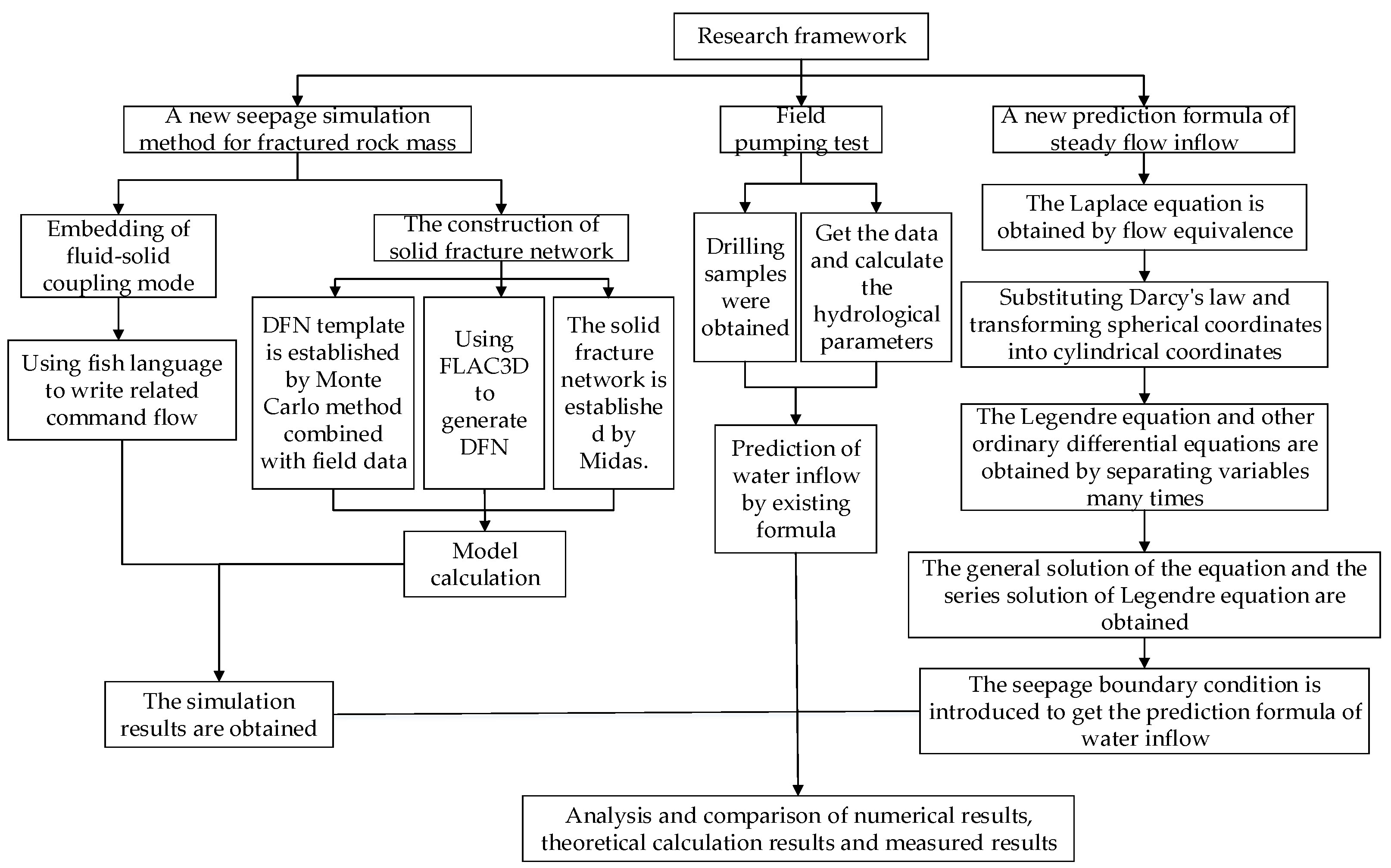
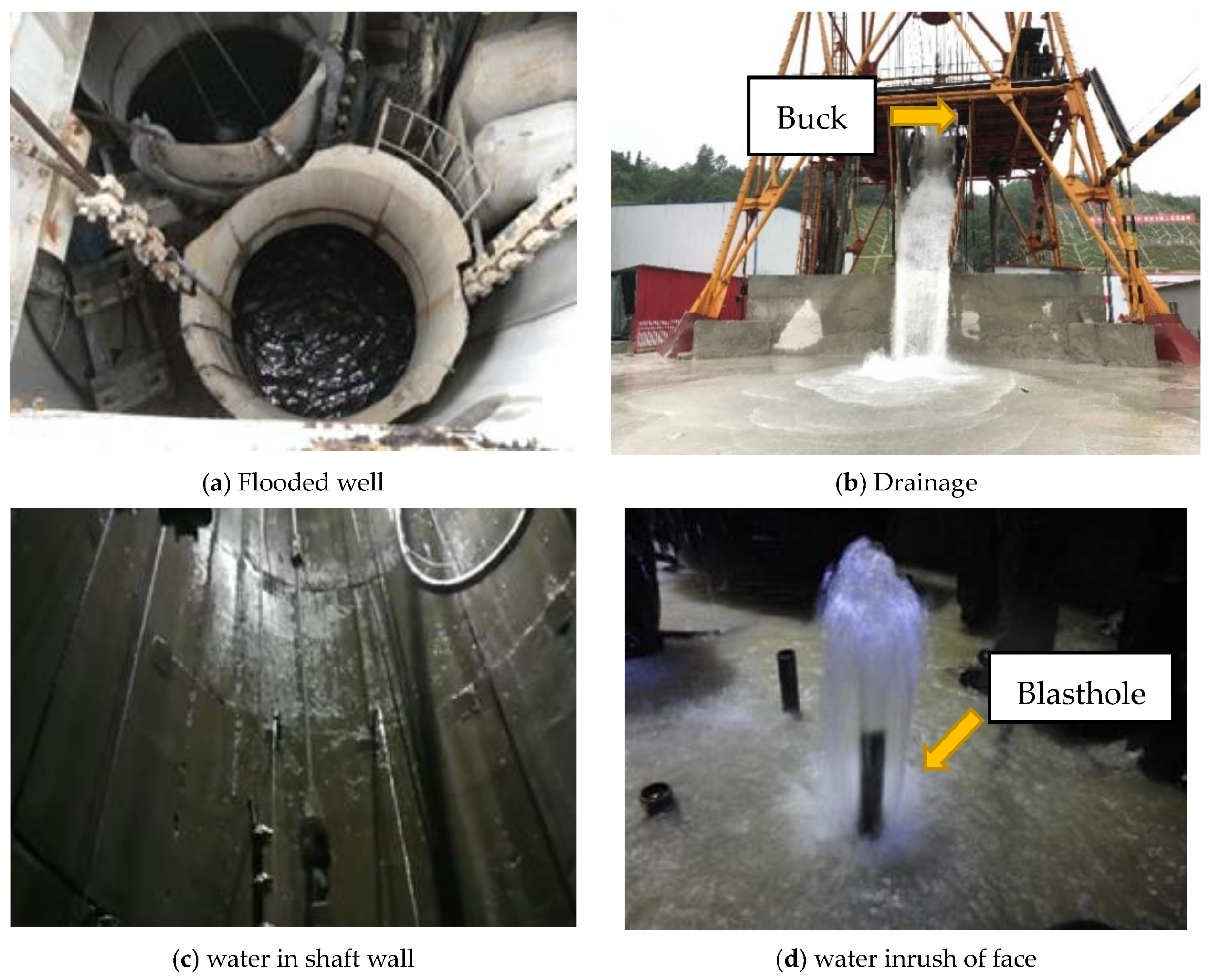


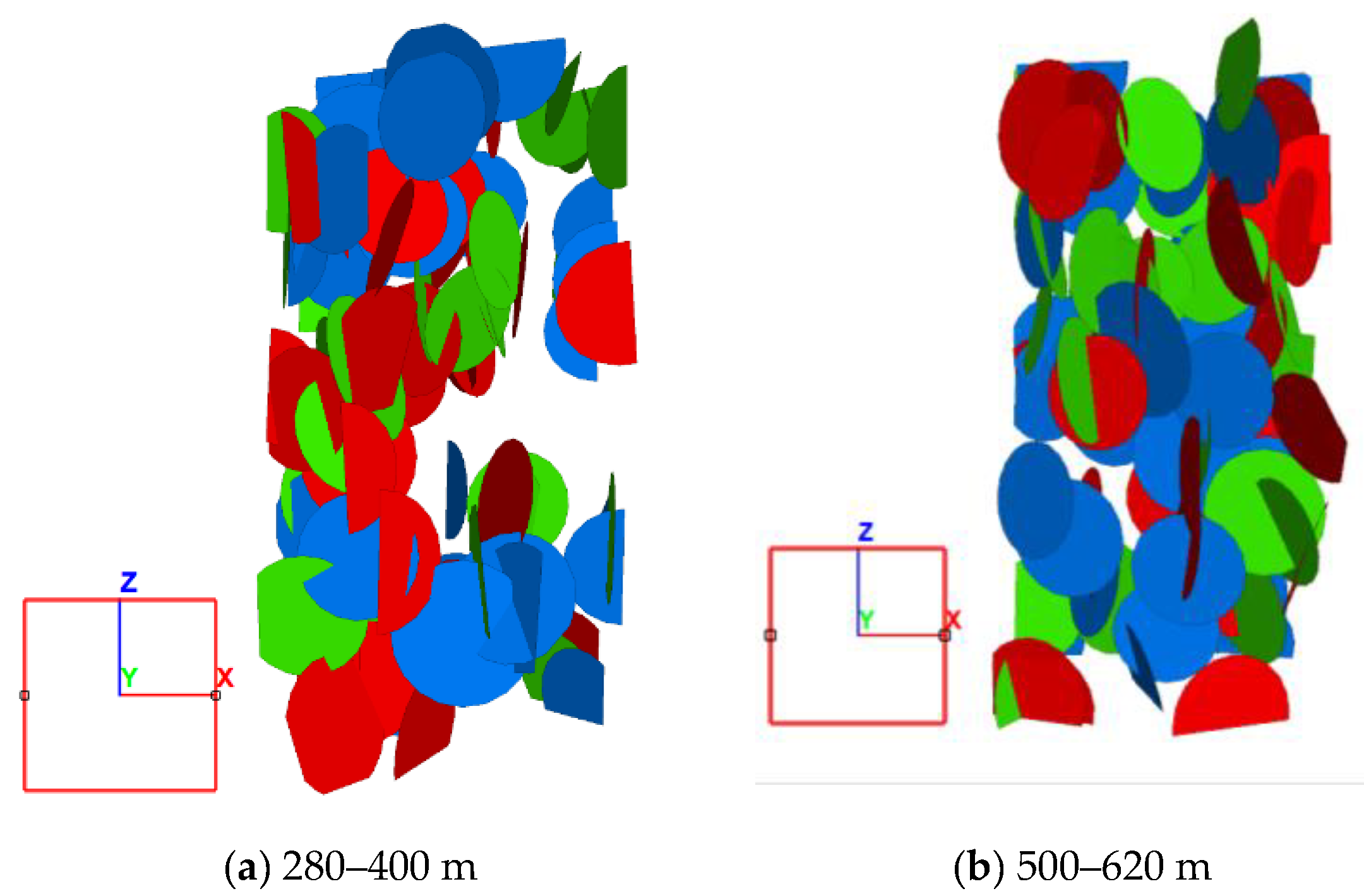

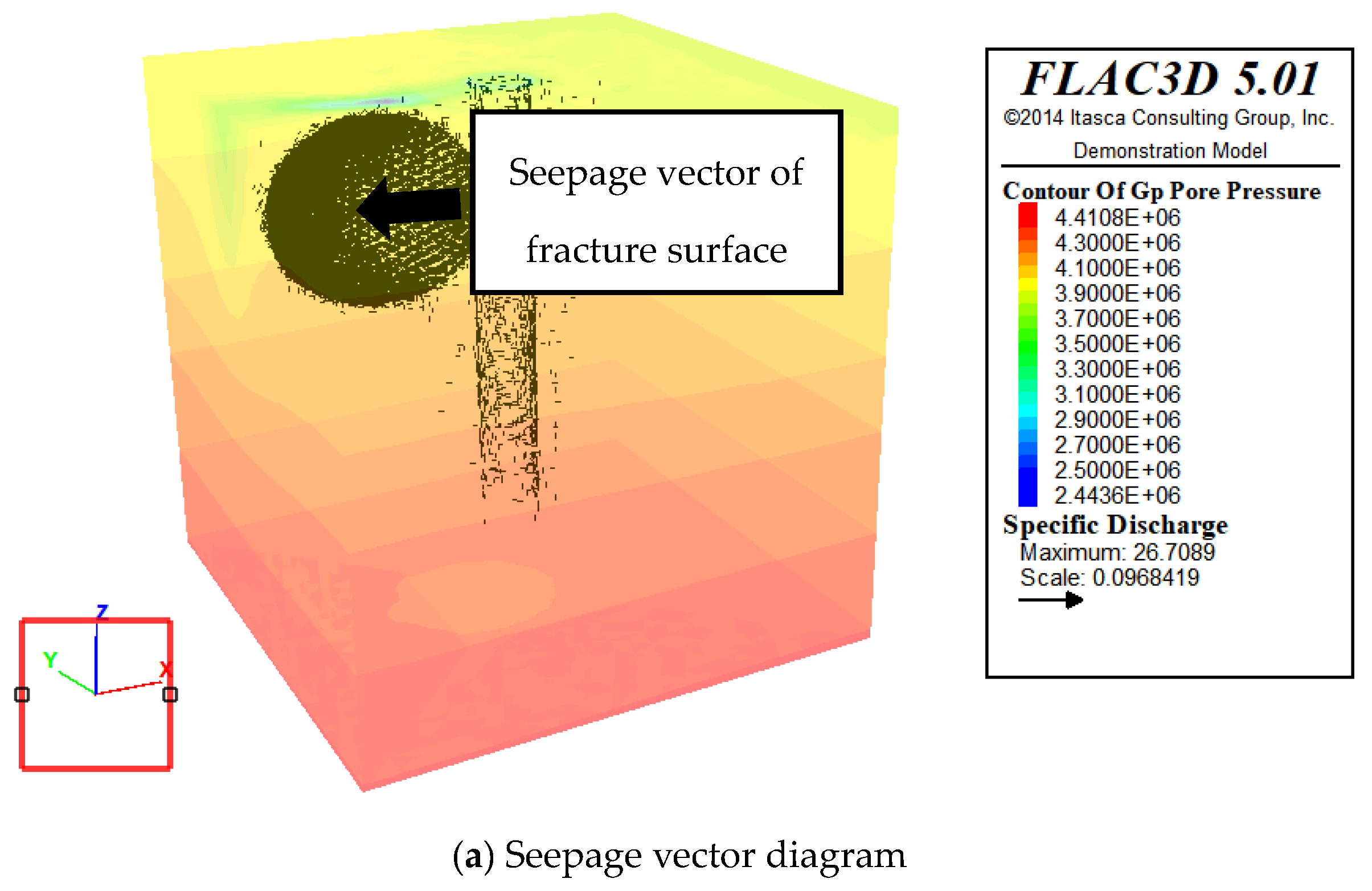
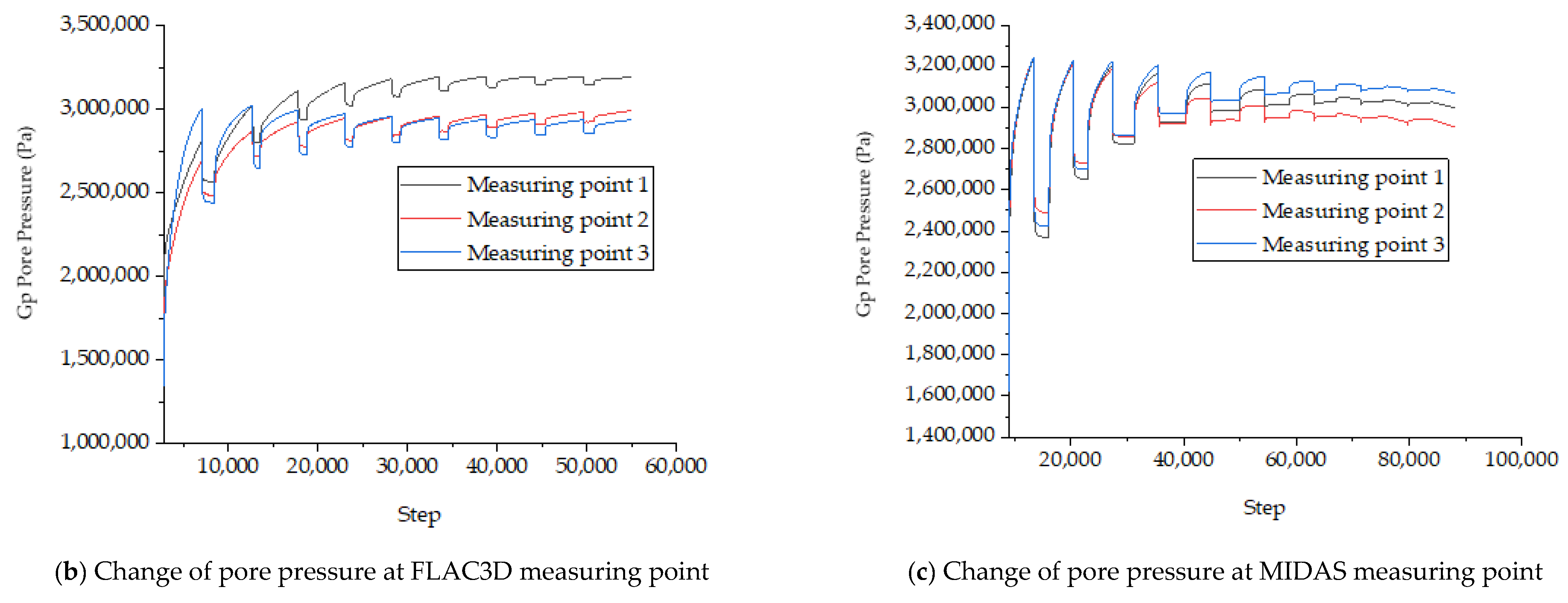
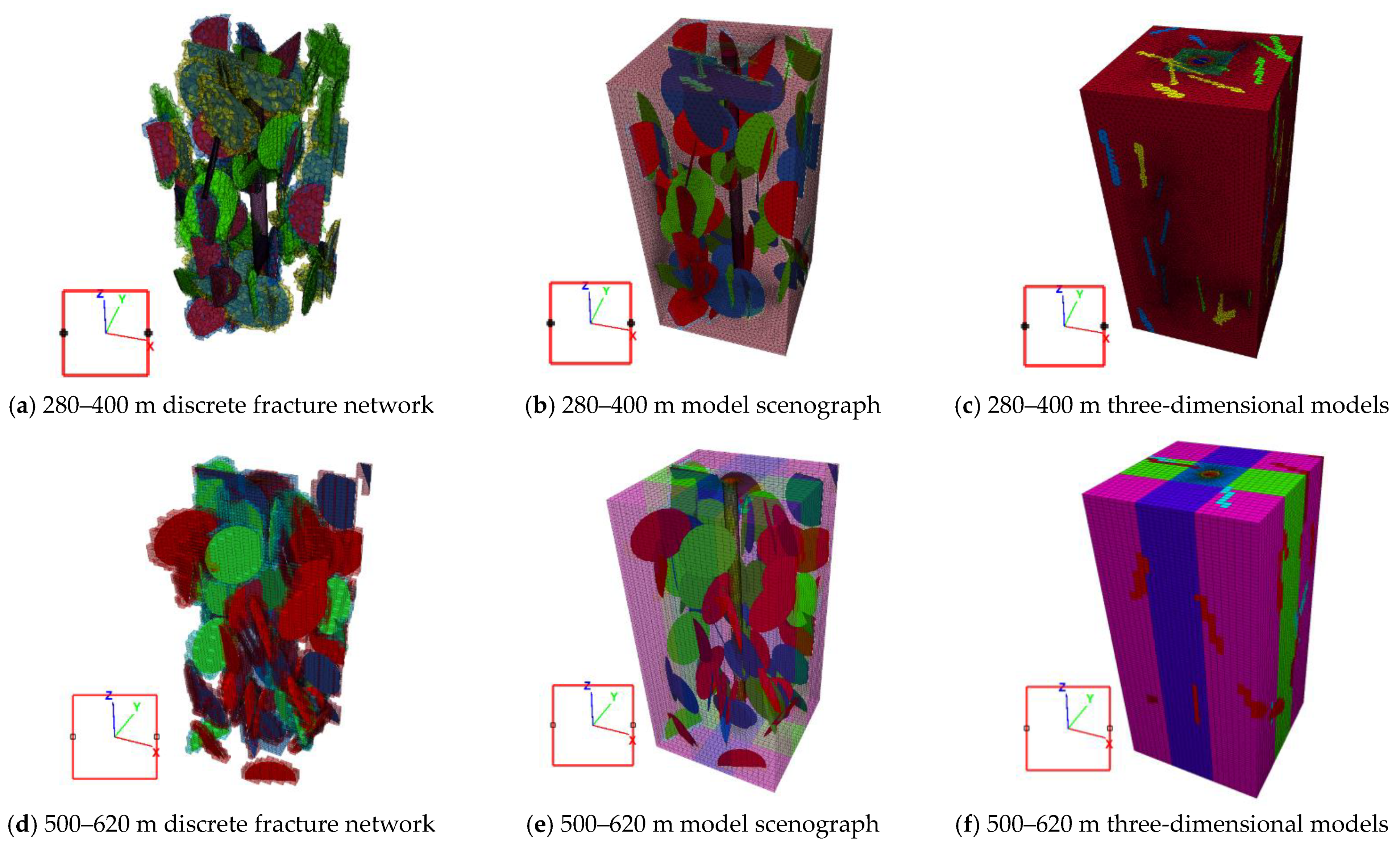

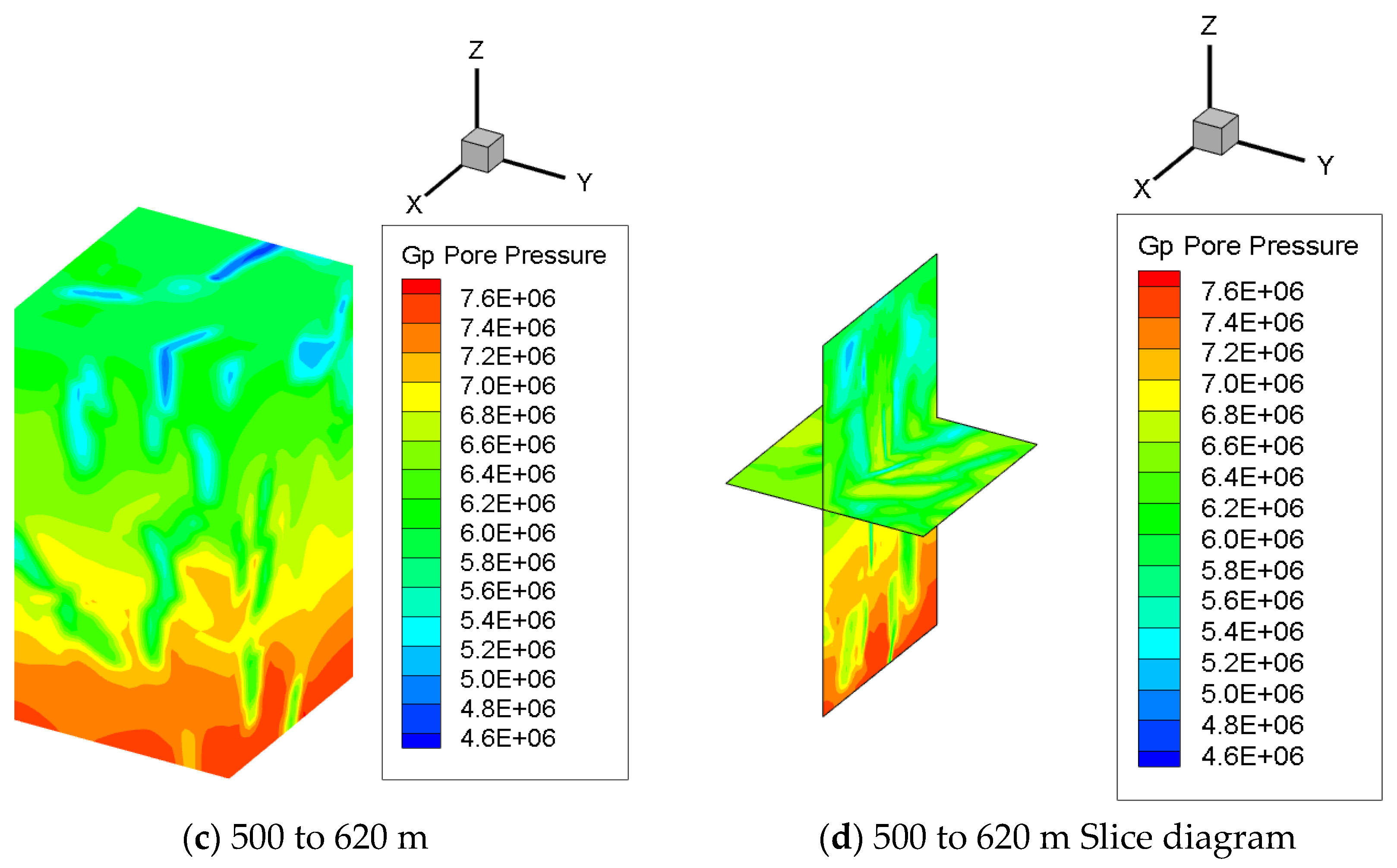
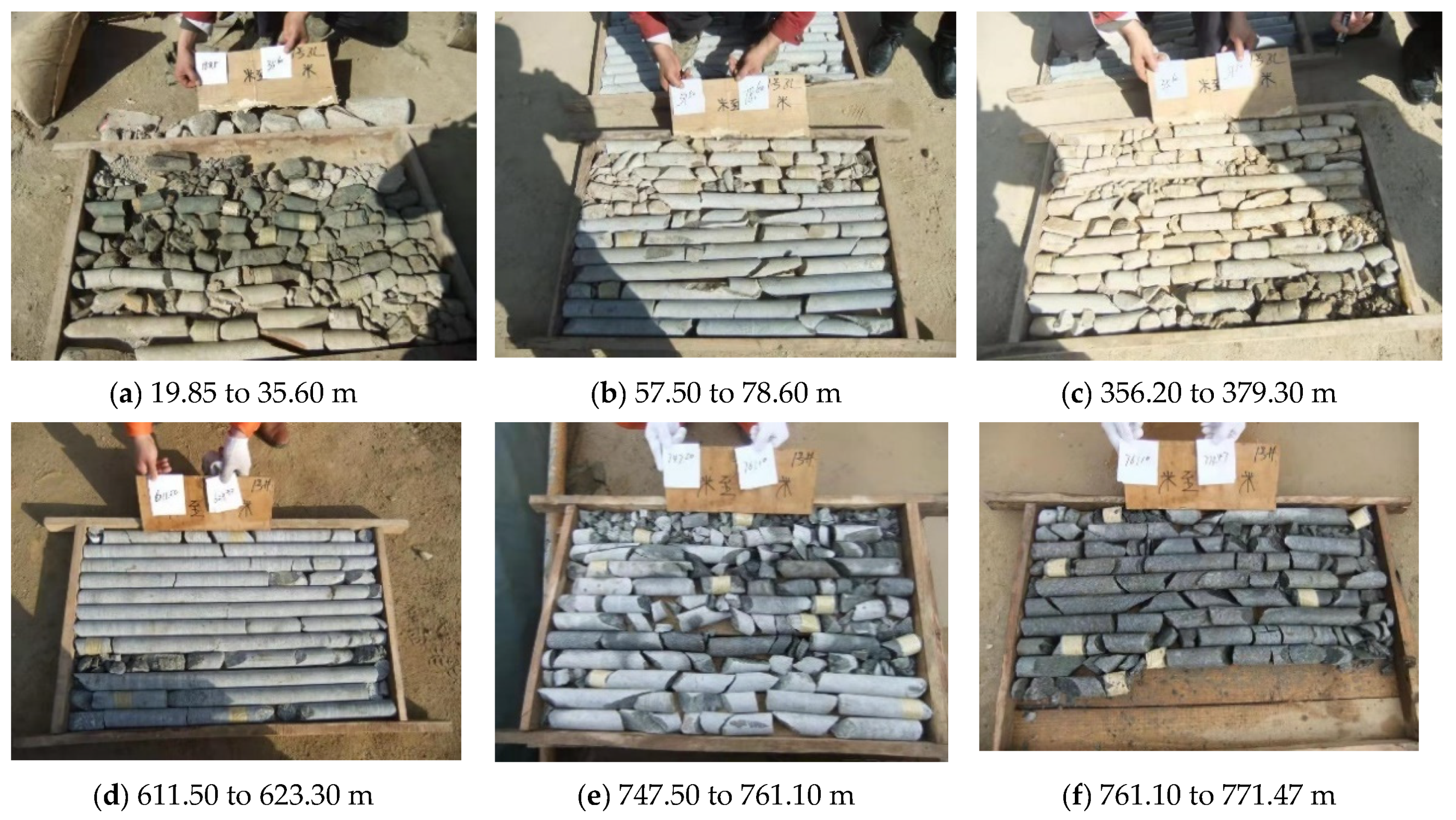
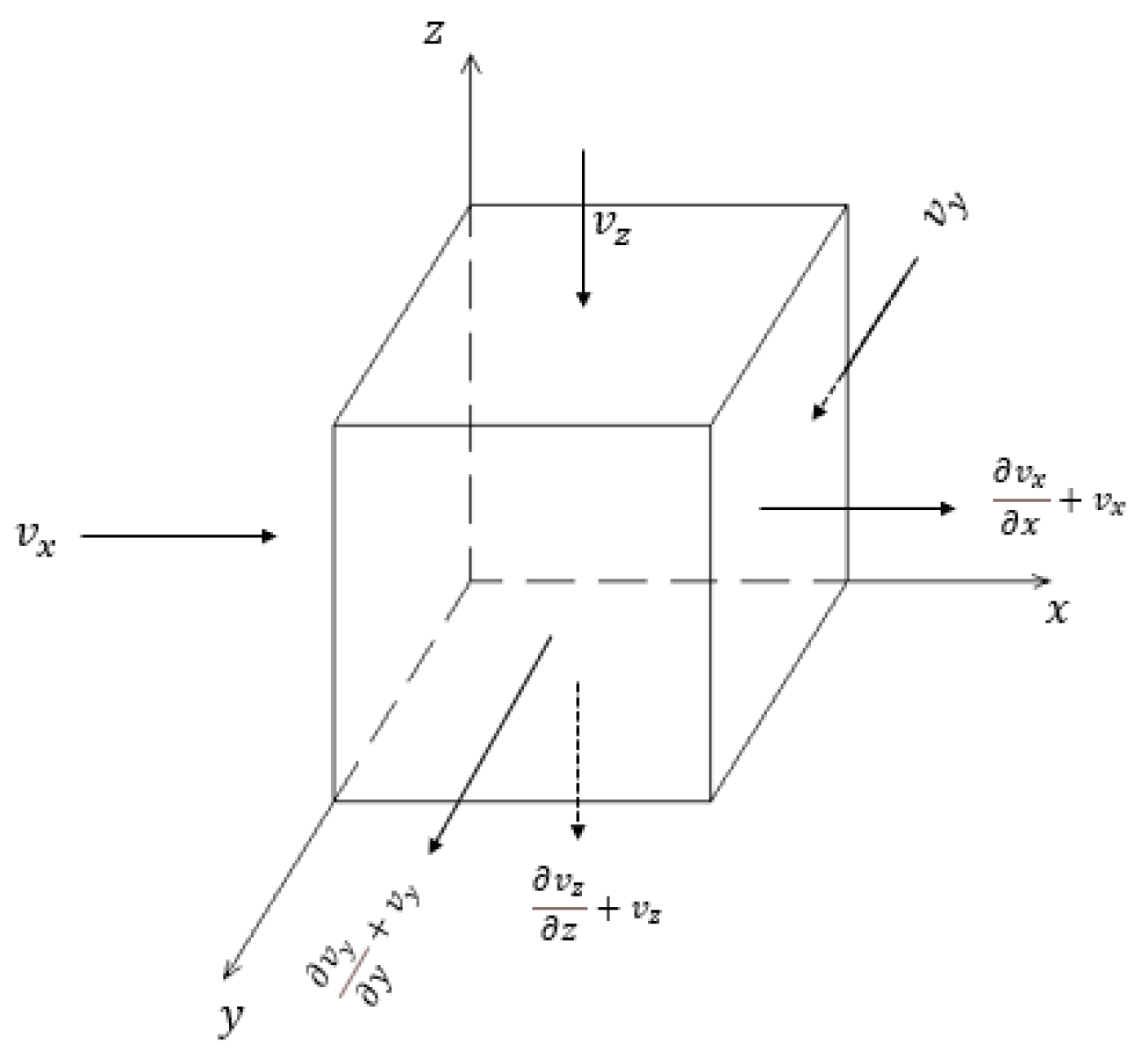
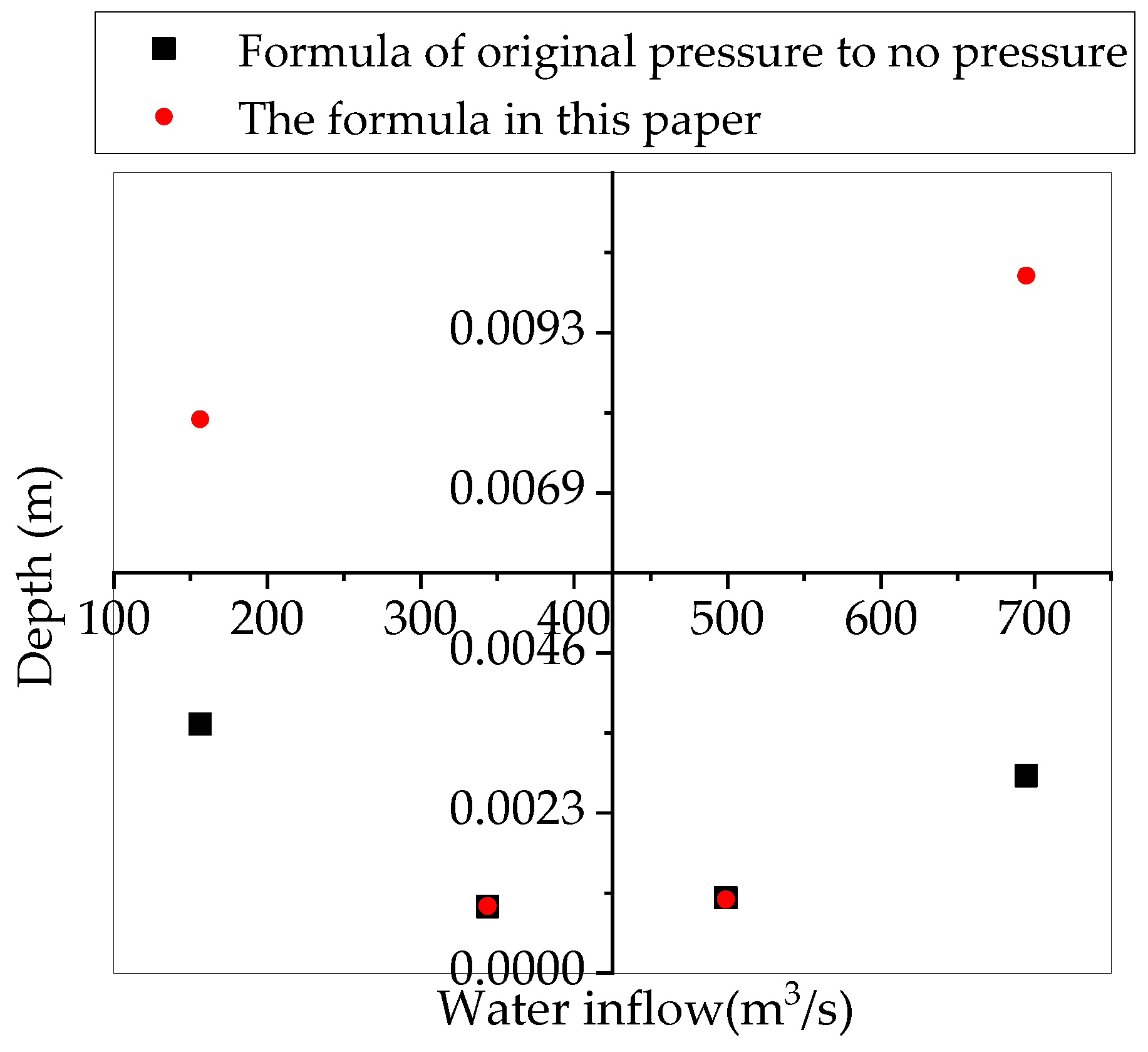
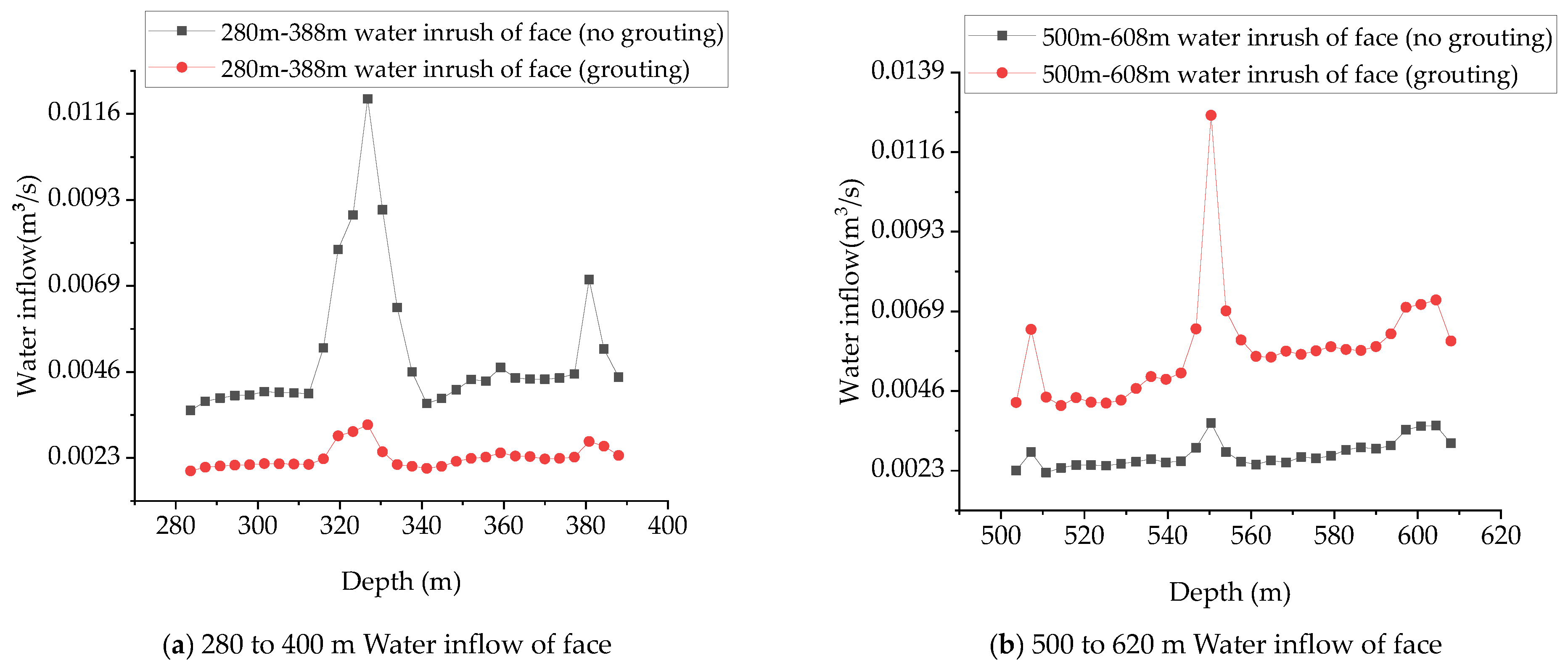

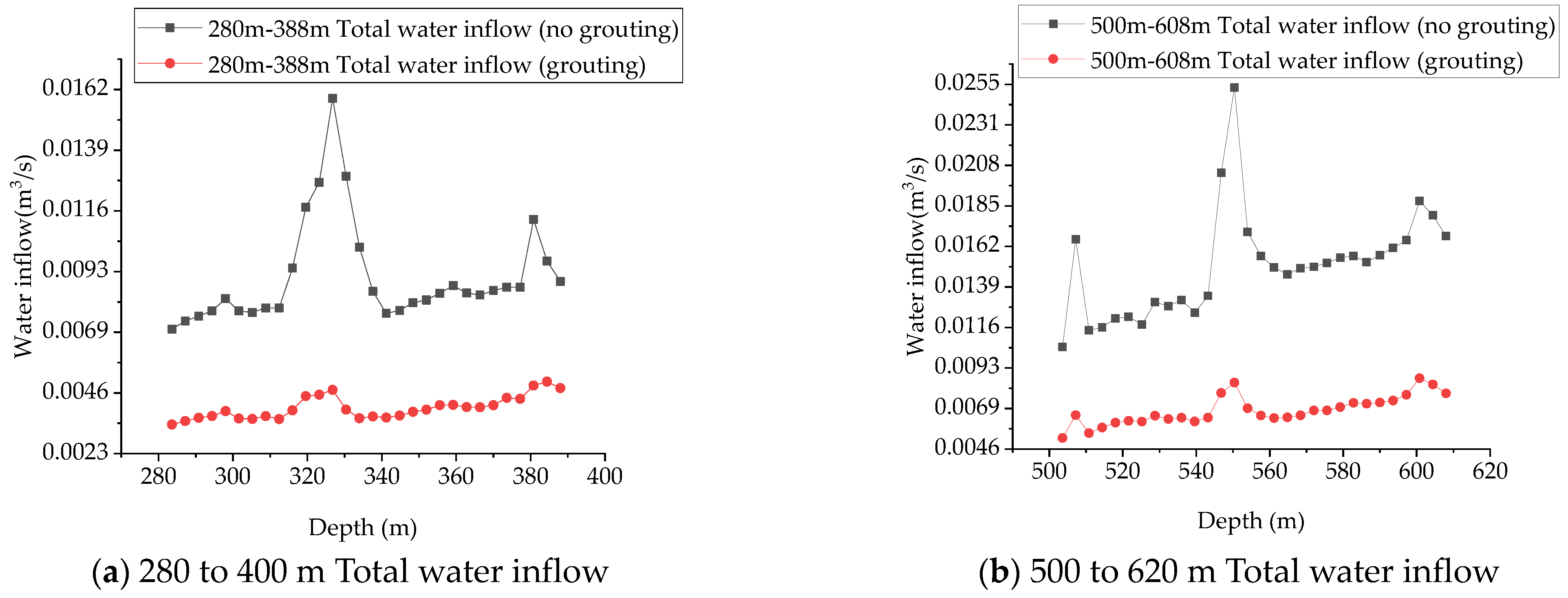
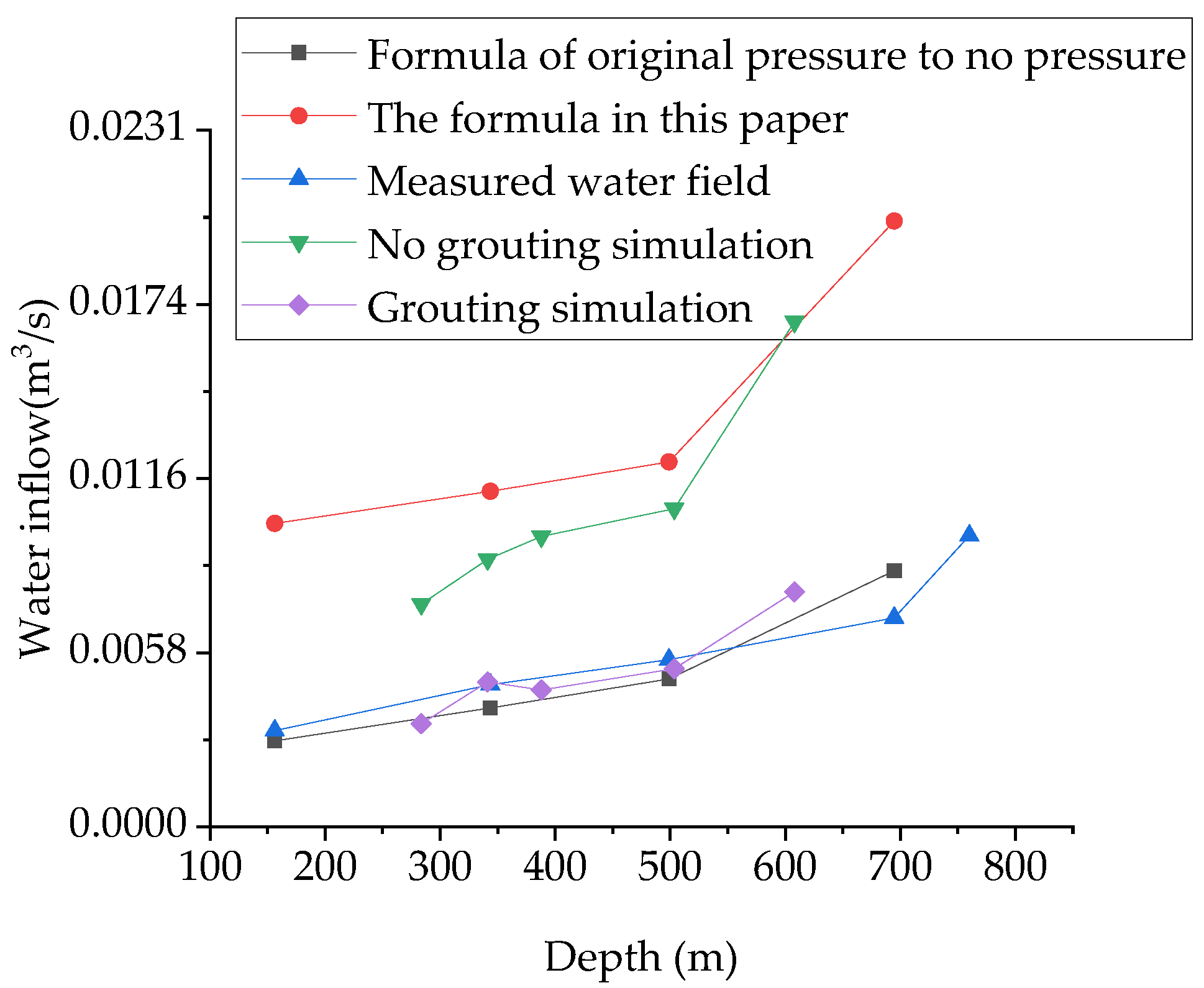
| Fracture Group | Central Point | Dip Angle (°) | Dip Direction (°) | Crack Trace Length(m) | Density (one/× 10−5 m2) | ||||
|---|---|---|---|---|---|---|---|---|---|
| Uniform Distribution | Gaussi | Gaussi | Gaussi | ||||||
| Mean Value u | Variance σ | Mean Value u | Variance σ | Mean Value u | Variance σ | Mean Value u | Variance σ | ||
| NE | NE | NE | NE | NE | NE | NE | NE | NE | |
| 1 | - | - | 79.00 | 11.03 | 133.00 | 9.00 | 36.00 | 10.00 | 7 |
| 2 | - | - | 82.10 | 8.13 | 161.06 | 11.71 | 33.90 | 11.71 | 7 |
| 3 | - | - | 89.33 | 6.10 | 33.61 | 9.90 | 26.10 | 6.60 | 7 |
| Soil Type | Elastic Modulus E/× 104 MPa | Poisson’s Ratio γ | Cohesion C/MPa | Internal Friction Angle φ/° | Tensile Strength/MPa | Density/g/cm3 | Height/m |
|---|---|---|---|---|---|---|---|
| Dark gray mixed granite (weakly weathered) | 0.53 | 0.30 | 5.00 | 33.00 | 13.00 | 2.11 | 0.00~−30.00 |
| Light gray mixed granite (developed joints) | 0.66 | 0.26 | 7.00 | 43.00 | 6.00 | 2.03 | −30.00~−60.00 |
| Dark gray mixed granite (developed joints) | 0.73 | 0.33 | 3.00 | 39.00 | 10.00 | 2.33 | −60.00~−80.00 |
| Light grey mixed granite (with relatively developed joints) | 0.96 | 0.29 | 10.00 | 36.00 | 19.00 | 2.43 | −80.00~−120.00 |
| Soil Type | Elastic Modulus E/× 104 MPa | Poisson’s Ratio γ | Cohesion C/MPa | Internal Friction Angle φ/° | Tensile Strength/MPa | Density/g/cm3 | Height/m |
|---|---|---|---|---|---|---|---|
| Dark gray mixed granite (weakly weathered) | 0.53 | 0.30 | 5.00 | 33.00 | 13.00 | 2.11 | 0.00~−30.00 |
| Light gray mixed granite (developed joints) | 0.66 | 0.26 | 7.00 | 43.00 | 6.00 | 2.03 | −30.00~−60.00 |
| Dark gray mixed granite (developed joints) | 0.73 | 0.33 | 3.00 | 39.00 | 10.00 | 2.33 | −60.00~−80.00 |
| Light grey mixed granite (with relatively developed joints) | 0.96 | 0.29 | 10.00 | 36.00 | 19.00 | 2.43 | −80.00~−120.00 |
| Fracture Group | Normal Stiffness (GN/m) | Tangential Stiffness (GN/m) | Internal Friction Angle (°) | Cohesion (MPa) | Shear Angle (°) | Tensile Strength (MPa) | Crack Width (mm) |
|---|---|---|---|---|---|---|---|
| 1 | 50 | 50 | 45 | 1 | - | - | 10 |
| 2 | 40 | 40 | 40 | 3 | - | - | 15 |
| 3 | 45 | 45 | 43 | 4 | - | - | 20 |
| Fracture Group | K1/× 10−9 cm/s | K2/× 10−9 cm/s | K3/× 10−9 cm/s |
|---|---|---|---|
| 1 | 0.000 | 1.70 | 1.70 |
| 2 | 0.000 | 1.36 | 1.36 |
| 3 | 0.001 | 0.57 | 0.57 |
| Name of Aquifer | Aquifer Depth (m) | Drawdown (m) | Water Inflow (L/s) | Unit Water Inflow (L/s m) | Aquifer Thickness (m) | Radius of Influence R (m) | Permeability Coefficient K (m/d) |
|---|---|---|---|---|---|---|---|
| Fourth aquifer | 3.03~694.75 | 98.12 | 0.3011 | 0.0031 | 1.25 | 555.92 | 0.321 |
| Third aquifer | 9.45~498.90 | 98.75 | 0.1399 | 0.0014 | 3.45 | 216.35 | 0.048 |
| Second aquifer | 9.33~343.70 | 98.73 | 0.1963 | 0.0020 | 3.70 | 249.77 | 0.064 |
| First aquifer | 0.00~156.25 | 71.36 | 1.0533 | 0.0148 | 1.75 | 758.57 | 1.130 |
| Aquifer Depth (m) | Permeability Coefficient K (m/d) | Static Water Level Height H (m) | Water Level in Well h (m) | Well Drops (m) | Radius of Influence R (m) | Shaft Waste Path r (m) | Aquifer Thickness (m) | Pressure to No Pressure Q (m3/d) |
|---|---|---|---|---|---|---|---|---|
| 3.03~694.75 | 0.321 | 691.72 | 0 | 691.72 | 3922.37 | 3.3 | 1.25 | 246.77 |
| 9.45~498.90 | 0.048 | 489.45 | 0 | 489.45 | 1075.63 | 3.3 | 3.70 | 94.26 |
| 9.33~343.70 | 0.064 | 334.37 | 0 | 334.37 | 849.20 | 3.3 | 3.45 | 83.26 |
| 0.00~156.25 | 1.130 | 156.25 | 0 | 156.25 | 1660.96 | 3.3 | 1.75 | 310.90 |
| Total | / | / | / | / | / | / | / | 735.19 |
| Aquifer Depth (m) | Permeability Coefficient K (m/d) | Static Water Level Height H (m) | Well Drops (m) | Radius of Influence R (m) | Shaft Waste Path r (m) | Q (m3/d) |
|---|---|---|---|---|---|---|
| 3.03~694.75 | 0.321 | 691.72 | 691.72 | 1383.44 | 3.3 | 871.21 |
| 9.45~498.90 | 0.048 | 489.45 | 489.45 | 978.90 | 3.3 | 92.17 |
| 9.33~343.70 | 0.064 | 334.37 | 334.37 | 668.74 | 3.3 | 83.93 |
| 0.00~156.25 | 1.130 | 156.25 | 156.25 | 312.5 | 3.3 | 691.89 |
| Total | / | / | / | / | / | 1739.20 |
Publisher’s Note: MDPI stays neutral with regard to jurisdictional claims in published maps and institutional affiliations. |
© 2021 by the authors. Licensee MDPI, Basel, Switzerland. This article is an open access article distributed under the terms and conditions of the Creative Commons Attribution (CC BY) license (https://creativecommons.org/licenses/by/4.0/).
Share and Cite
Li, J.; Wang, Y.; Tan, Z.; Du, W.; Liu, Z. Study on Water Inflow Variation Law of No.1 Shaft Auxiliary Shaft in HighLiGongshan Based on Dual Medium Model. Symmetry 2021, 13, 930. https://doi.org/10.3390/sym13060930
Li J, Wang Y, Tan Z, Du W, Liu Z. Study on Water Inflow Variation Law of No.1 Shaft Auxiliary Shaft in HighLiGongshan Based on Dual Medium Model. Symmetry. 2021; 13(6):930. https://doi.org/10.3390/sym13060930
Chicago/Turabian StyleLi, Jiabin, Yonghong Wang, Zhongsheng Tan, Wen Du, and Zhenyu Liu. 2021. "Study on Water Inflow Variation Law of No.1 Shaft Auxiliary Shaft in HighLiGongshan Based on Dual Medium Model" Symmetry 13, no. 6: 930. https://doi.org/10.3390/sym13060930





